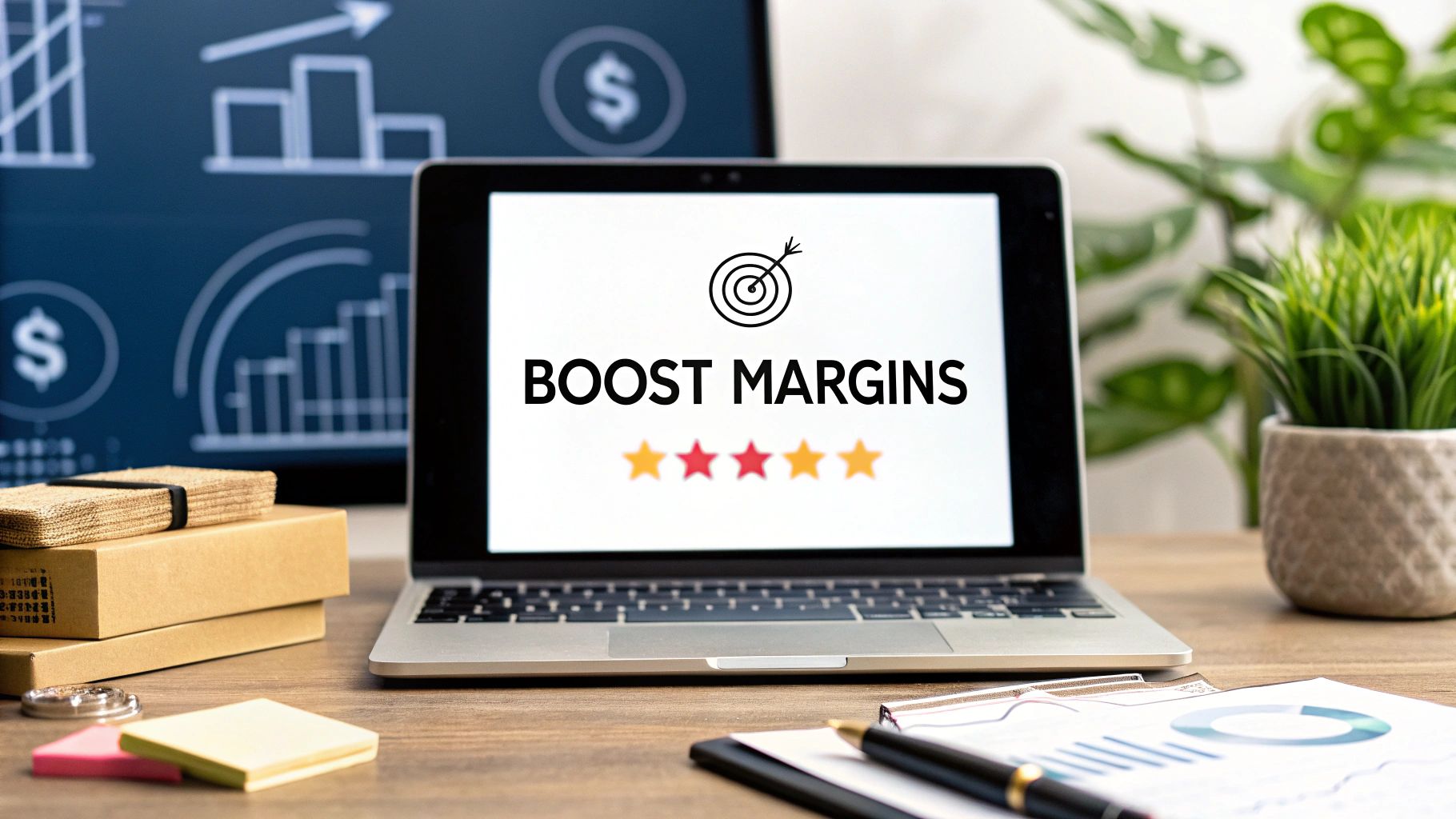The Real Truth About Drop Shipping Margins

The appeal of drop shipping often revolves around the perceived simplicity and potentially high profits. However, the reality often involves more complexity than many first anticipate. Successfully managing drop shipping margins requires a deep understanding of several contributing factors. This involves going beyond the basic selling price versus product cost and recognizing the frequently unseen expenses that can dramatically affect your net income.
Unveiling the Hidden Costs
Many beginning drop shippers concentrate solely on the difference between what a product costs and what they can sell it for. This approach overlooks key expenses that can significantly reduce profits. These often hidden costs can include marketing and advertising, platform fees, payment processing, customer service, and handling returns.
For instance, what might appear to be an enticing 25% margin could quickly shrink to 10% or less after accounting for these additional expenses. This highlights the importance of a thorough approach to calculating drop shipping margins.
The platform you choose also plays a critical role in determining your profit potential. Each platform has its own fee structure, which can impact your overall margins. While some platforms may offer lower transaction fees, they could have higher listing fees or monthly subscriptions. Understanding these platform-specific costs is vital for accurate margin calculation.
Dropshipping profit margins vary widely depending on the products and platforms used. In the UK, the average dropshipping profit margin typically falls between 15% and 20%. However, some e-commerce platforms offer substantially higher margins, often ranging from 30% to 40%. eBay dropshipping tends to have a lower margin, around 6%, contrasting with other platforms that often see higher profit margins.
Understanding these differences is critical for setting competitive prices while maintaining profitability. For example, a product sold for £100 with a cost of £80 results in a 20% margin, generally considered good for dropshipping. For a more detailed analysis of dropshipping profit margins, explore further statistics here.
Realistic Margin Benchmarks and Product Selection
While striving for high drop shipping margins is understandable, having realistic expectations is crucial, particularly in the UK market. Different product categories come with varying margin potentials.
Some niches, due to increased competition or lower average order values, naturally offer smaller margins. Other product categories, perhaps due to specialization or distinctive features, allow for healthier profit margins.
Therefore, thorough product research is essential to identify products with the potential for sustainable profitability. This means considering factors beyond attractive profit margins and carefully evaluating competition, market demand, and supplier reliability. Building a profitable drop shipping business requires a strategic approach to product selection and a comprehensive understanding of all costs involved.
Platform Selection: Where Your Margins Live or Die
Picking the right platform is paramount for your drop shipping business. Your chosen platform significantly impacts your profit margins. Each has its own fee structure, audience, and selling tools. Let's explore how platforms like Shopify, WooCommerce, Amazon, and eBay affect your potential earnings.
Shopify: Balancing Flexibility and Fees
Shopify offers a great deal of flexibility and control over your brand and customer experience. However, this comes with associated costs. Monthly subscriptions, transaction fees, and app costs can cut into your margins. While Shopify allows for higher product markups, you'll need to carefully consider these fees. For instance, a basic Shopify plan costs $29 per month, plus transaction fees from 0.5% to 2%. Successful scaling on Shopify requires a strategic approach to pricing and cost management.
WooCommerce: Lower Costs, Higher Effort
WooCommerce, a plugin for WordPress, presents a lower-cost alternative to Shopify. You'll avoid monthly subscription fees but will encounter other expenses like hosting, security, and plugin costs. WooCommerce offers greater control and potentially higher margins, but it also demands more technical expertise and hands-on management. This translates to a greater time investment, potentially impacting profitability.
Amazon: High Volume, Tight Margins
Amazon offers access to a huge customer base, leading to potentially high sales volume. However, competition is intense, often resulting in tighter margins. Amazon's fees, including referral fees and fulfillment costs, can further impact your profits. Success on Amazon depends on strategic product selection, competitive pricing, and effective advertising. Learn more in our article about How to master Amazon drop shipping.
eBay: Low Barrier to Entry, Lower Margins
eBay's low barrier to entry makes it appealing for beginners. However, competition is often fierce, resulting in lower profit margins. eBay’s fees, including listing fees and final value fees, can reduce your overall profit. Success on eBay requires focusing on niche products, competitive pricing, and excellent customer service.
Optimizing Your Platform Choice
To give you a clearer picture of the different platforms and their fees, we've compiled a comparison table:
Drop Shipping Platform Margin Comparison
A comprehensive comparison of popular e-commerce platforms and their impact on drop shipping profit margins
| Platform | Avg. Profit Margin | Monthly Fees | Transaction Fees | Best For |
|---|---|---|---|---|
| Shopify | 10-30% | $29+ | 0.5-2% + | Businesses focused on branding and customization |
| WooCommerce | 20-40% | Variable (hosting, etc.) | Variable (payment gateway) | Tech-savvy users wanting more control and lower upfront costs |
| Amazon | 5-15% | Variable (selling plan) | Referral fees + fulfillment costs | Businesses aiming for high sales volume |
| eBay | 5-20% | Variable (listing fees) | Final value fees | Beginners and those targeting niche markets |
This table illustrates the varying fee structures and potential profit margins across different platforms. Shopify and WooCommerce offer greater profit potential but come with varying levels of management overhead. Amazon and eBay offer easier entry points but generally yield tighter margins due to increased competition.
Regardless of the platform you choose, optimizing your operations is essential for maximizing profit. Key strategies include:
-
Strategic Pricing: Analyze your costs and set prices that cover expenses while staying competitive.
-
Efficient Marketing: Target your ideal customer with effective marketing to minimize acquisition costs.
-
Streamlined Operations: Automate tasks like order processing and customer service to reduce overhead.
-
Negotiated Supplier Rates: Build strong supplier relationships to secure better pricing and boost your margins.
Your platform choice will significantly influence your drop shipping experience. By evaluating each platform’s strengths and weaknesses, and implementing smart optimization techniques, you can set yourself up for success. Check out this resource for more insights: How to master platform selection for your online store.
Finding Products That Actually Make Money

Product selection is the cornerstone of successful drop shipping. Identifying products with strong drop shipping margins is crucial for profitability. It requires in-depth research, going beyond simple keyword searches and trend analysis. This involves understanding supplier pricing, competition, and true market demand.
Researching High-Margin Products
Profitable drop shippers use systematic research to find winning products before they become oversaturated. This includes analyzing market trends, identifying emerging product categories, and evaluating supplier pricing. Using tools like Google Trends can help identify rising product interest. Exploring niche forums can reveal unmet customer needs.
Assessing the competitive landscape is also vital. High demand coupled with high competition may not yield the desired profit margins. The goal is to find products with healthy demand and manageable competition. This balance allows for effective marketing and profitable pricing.
Differentiating and Positioning Your Products
Finding a product with decent margins isn't enough. Successful drop shippers differentiate their products and position them strategically for premium prices. This might involve focusing on a niche, offering unique product bundles, or providing exceptional customer service.
Go beyond simply reselling. Focus on adding value for the customer. This could involve bundling related products, offering personalized service, or crafting unique marketing campaigns. These strategies justify higher prices and foster customer loyalty.
Leveraging Trends and Emerging Markets
Capitalizing on seasonal trends, like holiday-specific products, can significantly boost sales and profitability during peak seasons. Identifying emerging product categories before the competition can unlock substantial margin potential.
For example, as new technologies appear, identifying related products early provides a first-mover advantage. This allows you to establish market presence and secure higher margins before market saturation. This foresight is key to long-term drop shipping success.
The UK dropshipping market shows significant growth potential. It’s projected to reach USD 134.12 billion by 2033, growing at a CAGR of 22.88% from 2023 to 2033. This growth, driven by strong online demand and relatively low competition, particularly benefits the fashion segment and domestic suppliers. Discover more insights about the UK drop shipping market. This expanding market presents numerous opportunities for those who effectively identify and capitalize on emerging trends.
Finding the right products isn't luck; it's about strategic research, differentiation, and recognizing opportunities. This approach is fundamental to maximizing your drop shipping margins and building a sustainable, profitable business.
Supplier Partnerships That Boost Your Bottom Line

Your relationship with your suppliers significantly influences your drop shipping margins. Finding reliable suppliers with competitive pricing is just the beginning. Negotiating favorable terms and building strong relationships can unlock substantial margin improvements, leading to a healthier bottom line for your business.
Finding the Right Suppliers
Identifying reliable suppliers who offer competitive prices without compromising quality is crucial for maximizing drop shipping margins. Start by researching potential suppliers in your niche. Look for established suppliers with positive reviews and efficient shipping processes.
Thoroughly vet each potential supplier. Request samples to evaluate product quality, inquire about shipping times and costs, and assess their customer service responsiveness. This proactive approach helps minimize the risk of unforeseen issues impacting your margins.
Diversifying your supplier base is also important. Partnering with multiple suppliers can mitigate risks related to stock shortages, price fluctuations, and unexpected disruptions, protecting and even enhancing your drop shipping margins.
Negotiating for Better Terms
After identifying suitable suppliers, the next step is negotiating favorable terms. Don't hesitate to negotiate. Many suppliers are open to offering better pricing, particularly for larger orders or long-term partnerships.
Consider these negotiation strategies:
- Volume Discounts: Secure lower per-unit costs by leveraging larger order quantities.
- Exclusive Arrangements: Negotiate exclusive deals for specific products or variations.
- Preferred Partner Status: Build long-term partnerships to gain access to preferential pricing and priority service.
These tactics can substantially improve your drop shipping margins, giving you a competitive edge. Strong supplier relationships can also unlock additional benefits like faster shipping, dedicated support, and early access to new products. Read more about supplier negotiations: How to master supplier negotiations.
Evaluating Supplier Reliability and Performance
A robust supplier network is essential for healthy drop shipping margins. Regularly evaluate supplier reliability, shipping performance, and product quality. These factors directly affect customer satisfaction and return rates, ultimately impacting your profitability.
Implement a framework for evaluating suppliers:
- Shipping Speed: Track average shipping times and delivery consistency.
- Product Quality: Regularly assess product quality through samples and customer feedback.
- Communication Responsiveness: Monitor how quickly and effectively suppliers address your inquiries.
Addressing performance issues promptly prevents them from negatively affecting your margins. This proactive approach strengthens supplier relationships and contributes to long-term success. Interestingly, manufacturers in the UK and globally are seeing increased profit margins through dropshipping. Around 53% of manufacturers report higher margins by bypassing traditional retail and negotiating better terms with e-retailers. Find more detailed statistics here. Strong supplier partnerships are more than just a source of products; they are key to maximizing drop shipping margins and building a sustainable, profitable business. They are strategic allies in your business’s success.
Operational Excellence: Protecting Margins Daily

Beyond choosing winning products and competitive pricing, your day-to-day operations are key to maintaining healthy drop shipping margins. These practices can significantly impact your long-term profitability. It's about streamlining your workflows to minimize overhead without compromising the customer experience.
Automation for Efficiency
Smart drop shippers recognize the value of automation. Automating essential tasks like order processing, inventory management, and even some customer service functions can substantially reduce operational costs. However, not every automation tool offers a good return on investment.
Focus on tools that integrate smoothly with your ecommerce platform and address your specific business needs. For example, automated inventory updates prevent selling out-of-stock items, a common issue that can lead to customer dissatisfaction. Automated order processing minimizes manual errors and accelerates fulfillment times. These efficiency gains directly boost your drop shipping margins.
Minimizing Returns and Chargebacks
Returns and chargebacks can quietly erode your profits. Implementing strategies to minimize these occurrences is vital for protecting your margins. Start with accurate and detailed product descriptions, accompanied by high-quality product images.
Clearly communicating shipping times and return policies also manages customer expectations, leading to fewer returns. Excellent customer service is another powerful tool. Addressing customer inquiries promptly and effectively builds trust and encourages customers to seek resolutions rather than initiating chargebacks. This proactive approach safeguards your margins and fosters positive customer relationships. For more information, check out this article: How to master post-sale customer service.
Optimizing Your Website for Conversions
Your website is your digital storefront. Optimizing it for conversions is a powerful lever for improving your margins without increasing your marketing budget. A clean, user-friendly website design, combined with compelling product descriptions and high-quality imagery, can significantly improve conversion rates.
This translates to more sales from your existing traffic, contributing directly to higher profits. Other website optimizations include streamlining the checkout process, offering diverse payment options, and showcasing positive customer testimonials. These improvements enhance the customer experience and encourage purchases, ultimately boosting your bottom line.
Cost-Effective Customer Acquisition
Acquiring new customers can be costly, but it doesn't have to be. Cost-effective acquisition strategies are essential for healthy margins. Consider focusing on organic marketing channels like search engine optimization (SEO) and social media marketing, rather than relying solely on paid advertising.
Targeted advertising campaigns, focused on specific demographics and interests, can maximize your return on ad spend. Building an email list and nurturing your subscribers can drive repeat business, reducing your dependence on expensive acquisition channels.
Financial Management for Clarity
Sound financial management provides crucial insights into your actual profit. Meticulously tracking your expenses, including marketing costs, platform fees, and supplier costs, enables you to accurately calculate your drop shipping margins. This clarity helps identify areas for improvement and make informed, data-driven decisions.
Using financial management software can streamline this process and offer real-time visibility into your profitability. This empowers you to closely monitor your margins and adapt as needed to ensure sustainable success. Understanding your financials is key to maximizing your earnings.
To illustrate how different operational costs can impact your profit margins, consider the following table:
Operational Costs Impact on Drop Shipping Margins
Analysis of how different operational costs affect overall profit margins in drop shipping businesses
| Operational Area | Typical Cost (%) | Impact on Margins | Optimization Strategies |
|---|---|---|---|
| Marketing & Advertising | 10-20% | Can significantly reduce margins if not managed effectively | Targeted advertising, SEO, social media marketing, influencer marketing |
| Product Costs | 50-70% | Largest impact on margins; finding competitive suppliers is crucial | Negotiate with suppliers, explore different sourcing options |
| Shipping & Handling | 5-15% | Can vary significantly based on product size and weight | Offer free shipping thresholds, optimize packaging |
| Platform Fees | 2-5% | Varies based on platform; can be a fixed fee or percentage of sales | Choose the right platform, consider transaction fees |
| Customer Service | 5-10% | Can increase with higher return rates or complex inquiries | Automate responses, provide clear FAQs |
| Returns & Chargebacks | 2-10% | Directly reduces profit; can be impacted by product quality and customer satisfaction | Improve product descriptions, implement robust return policies |
By understanding and optimizing these operational costs, drop shippers can effectively protect and even improve their profit margins. Focusing on efficient processes, strategic cost management, and excellent customer service is crucial for long-term success in the competitive drop shipping landscape.
Scaling Without Sacrificing Your Profit Margins
Many dropshipping businesses see their profit margins shrink as they grow. However, this isn't an inevitable side effect of expansion. By learning from successful merchants, we can discover how to scale strategically and maintain, or even improve, profit margins.
Advanced Inventory Management for Scalable Growth
As your business expands, inventory management becomes increasingly complex, potentially leading to higher costs if not handled strategically. Advanced inventory management is crucial for supporting growth without proportionally increasing expenses.
This includes using inventory forecasting methods to anticipate demand, preventing stockouts and overstocking. Integrating your inventory management system with your sales channels provides real-time updates and prevents selling out-of-stock items. This reduces customer service issues and boosts efficiency, ultimately benefiting your bottom line.
Multi-Channel Selling Strategies for Maximum Profit
Selling across multiple channels can dramatically increase reach and revenue. However, managing inventory and pricing across various platforms can become a challenge. Multi-channel selling strategies are essential for effectively distributing your catalog across platforms like Amazon, eBay, and your own Shopify store.
This involves understanding each platform's unique audience and pricing dynamics to maximize profits. Some products may perform better on one platform than another due to demographics or competition. Strategically distributing products and adjusting pricing accordingly can maximize overall profitability.
Team Building and Outsourcing for Sustainable Operations
Growth requires more resources, both human and technological. A skilled team is vital for handling increased order volume, customer inquiries, and marketing. However, a large in-house team can be expensive.
Outsourcing tasks like customer service or order fulfillment can be a cost-effective way to support growth while protecting margins. Documenting your processes ensures smooth onboarding for new team members and operational consistency, minimizing errors and improving efficiency.
Process Documentation for Streamlined Efficiency
Well-defined processes are essential for maintaining efficiency during scaling. Documenting procedures, from order fulfillment to customer service, creates a standardized system, reducing errors and improving consistency.
This documentation also helps train new team members, allowing them to become productive quickly and contribute to growth without sacrificing valuable time or impacting your margins. This systematic approach ensures sustainable operations and protects profitability.
Dropshipping is increasingly important in e-commerce, with about 27% of businesses using it as their primary sales model. This model thrives in the UK due to simplified online store setup and lower overhead than traditional businesses. Explore this topic further. This growth creates numerous opportunities for businesses to scale strategically and maintain profitability.
Ready to take control of your TikTok Shop sales and maximize profit margins? Mergoio provides real-time analytics and powerful tools to optimize operations and boost your bottom line. Start your free trial with Mergoio today!

Leave a Reply